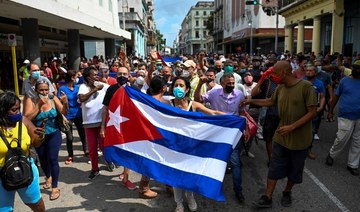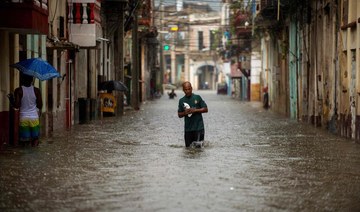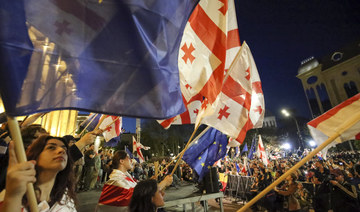HAVANA: Havana’s streets were calm Monday on the one-year anniversary of unprecedented anti-government demonstrations, with Cubans denouncing a pre-emptive security clampdown to avoid a repeat.
Amid fresh accusations of human rights abuses and calls from the United States for the Cuban government to “respect” dissident voices, President Miguel Diaz-Canel said he was convinced the country would emerge from what he described as a “complex situation.”
There had been calls for new protests on the anniversary, but more than a dozen dissidents, artists and independent journalists said on Twitter they had received warnings from the police not to leave their homes, from where some reported patrols outside.
They also included the parents of protesters in jail.
“I am under siege,” tweeted Yurka Rodriguez, the mother of 25-year-old Yunaikis Linares, one of hundreds placed behind bars by the communist regime.
Rodriguez used the hashtag #SOSCuba.
“No one will go out on the street,” student Carlos Rafael Dominguez, 18, told AFP.
“There is no bringing it (the government) down,” he said resignedly.
Added 64-year-old Maria de los Angeles Marquez: “People are resisting going out” because of the heavy sentences — up to 25 years in some cases — meted out for participation in last year’s spontaneous outburst of anti-government ire.
Mass protests broke out across Cuba on July 11 and 12 last year, with demonstrators clamoring for food and freedoms amid the island’s worst economic crisis in 30 years, and shortages of fuel, medicines and food.
A crackdown by the security forces left one dead, dozens injured and 1,300 people detained, according to rights observers.
Hundreds, including minors, have since been given jail sentences for such crimes as “public disorder,” “contempt” or “sedition.”
In a report published on the one-year anniversary of the protests, Human Rights Watch detailed “systematic human rights violations” committed by the government to quash further dissent.
The report listed claims of “arbitrary detention, abuse-ridden prosecutions, beatings and other cases of ill-treatment that in some cases constitute torture.”
“A year ago today, thousands of Cubans protested, demanding rights and freedoms, but the government gave many of them only two options: prison or exile,” said Juan Pappier, senior Americas researcher at HRW.
Diaz-Canel, who has described the protests as “a vandalistic coup,” tweeted Monday that “if anything is to be commemorated this 11th of July, it is the victory of the Cuban people, the Cuban revolution.”
Cuba has for the past six decades been the target of US sanctions that the government blames for the island nation’s economic woes.
Citing a backdrop of “constant economic, political and ideological siege,” the president said he was “convinced that we will also emerge from this complex situation.”
Cuba accuses the United States of fomenting last year’s protests.
In a statement Monday, US Secretary of State Antony Blinken said Washington recognized the “determination and courage” of the Cuban people “as they continue to fight for respect for human rights.”
The HRW report documented 155 cases of abuse as part of the “repression against July 2021 protesters.”
This included detention of people protesting peacefully or on their way to join marches, and detainees held incommunicado sometimes for months on end without access to relatives or a lawyer.
It also reported unsanitary prison cells, and little or no access to food, medicines, clean water or Covid-19 masks.
“Many (detainees) said they were subject to abusive and repeat interrogations... Some were beaten, forced to squat naked, or subjected to ill-treatment, including sleep deprivation and other abuses that in some cases amount to torture,” said the report.
Orestes Sandoval, an 80-year-old queuing to buy cigarettes in the Cuban capital, told AFP a new round of protests was unlikely.
“With everything that has happened, I don’t believe anyone would dare to do such a thing.”
Cubans decry pre-emptive clampdown on protest anniversary
https://arab.news/w9w5j
Cubans decry pre-emptive clampdown on protest anniversary
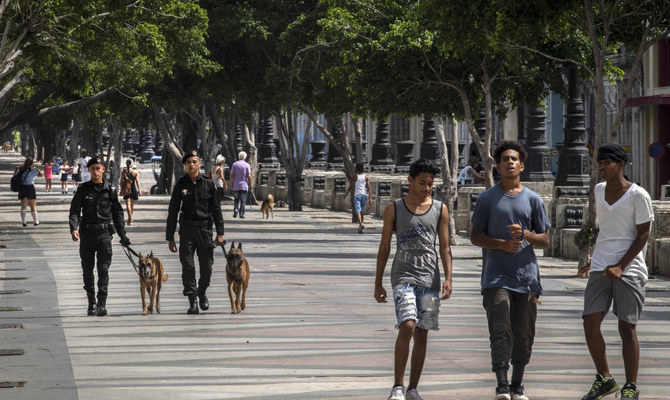
- In a report published on the one-year anniversary of the protests, Human Rights Watch detailed “systematic human rights violations” committed by the government to quash further dissent
Biden blames China, Japan and India’s economic woes on ‘xenophobia’
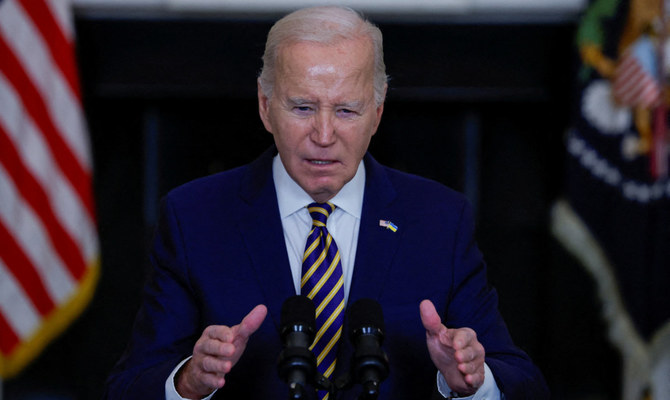
- Concern about irregular migration has become a top issue for many US voters ahead of November’s presidential election
WASHINGTON: President Joe Biden said on Wednesday that “xenophobia” from China to Japan and India is hobbling their growth, as he argued that migration has been good for the US economy.
“One of the reasons why our economy’s growing is because of you and many others. Why? Because we welcome immigrants,” Biden said at a Washington fundraising event for his 2024 re-election campaign and marking the start of Asian American, Native Hawaiian and Pacific Islander Heritage Month.
“Why is China stalling so badly economically, why is Japan having trouble, why is Russia, why is India, because they’re xenophobic. They don’t want immigrants. Immigrants are what makes us strong.”
The International Monetary Fund forecast last month that each country would see its growth decelerate in 2024 from the year prior, ranging from 0.9 percent in highly developed Japan to 6.8 percent in emerging India.
They forecast that the United States would grow at 2.7 percent, slightly brisker than its 2.5 percent rate last year. Many economists attribute better-than-expected performance partly to a migrants expanding the country’s labor force.
Concern about irregular migration has become a top issue for many US voters ahead of November’s presidential election.
Biden, who has condemned the rhetoric of his Republican opponent Donald Trump as anti-immigrant, has worked to court broad economic and political relations with countries including Japan and India to counter China and Russia globally.
Trump blasts Biden in rare day on campaign trail

WAUKESHA, US: Donald Trump used a break in his hush money trial to stage back-to-back appearances in two Midwestern battleground states Wednesday — but kept his legal woes front-and-center as he accused President Joe Biden of weaponizing the courts against him.
The former Republican president, who is running for a return to the White House, rallied supporters in Wisconsin and Michigan, among the most hotly contested states in his expected rematch with Democrat Biden in November.
The speeches featured all of Trump’s go-to set-pieces, from complaints about environmentally friendly household appliances to apocalyptic warnings of a looming world war — but his evening speech in Michigan was notable for its vitriol.
“Every single thing he touches turns to shit,” Trump said of Biden in a speech in Freeland, Michigan peppered with profane language about his criminal charges, his 2020 election defeat and his determination to win reelection in November.
Trump had already spoken in an afternoon rally in the Wisconsin town of Waukesha, where he railed against Biden’s handling of the economy and immigration.
In both appearances he accused Democrats of “executing” newborn babies as he turned to the deeply divisive issue of abortion rights, and in both he revived baseless claims that Biden is behind the 88 felony charges he is facing.
“I’ve got to do two of these things a day,” he told a sea of red hats at his Michigan rally.
“You know why? Because I’m in New York all the time with the Biden trial — a fake trial that all of the legal scholars say is a disgrace,” he said in Michigan.
Trump regularly claims that his indictments — three for alleged cheating in elections and one for hoarding classified documents — are being orchestrated as part of a political witch hunt, but never offers any evidence.
The 77-year-old tycoon used his rare day on the stump to project his preferred image as a confident, seasoned campaigner, far from the Manhattan courtroom where he is accused of covering up payments to a porn star before the 2016 presidential election.
Trump is the first former US president to face criminal charges, and the trial appears to have annoyed him to no end.
For two weeks he has been sitting through long hours of witness testimony, visibly bored and angry at no-nonsense Judge Juan Merchan, who required him to be present — and then imposed a gag order prohibiting Trump from publicly attacking witnesses, jurors or court staff.
Before and after each day’s proceedings, Trump has been addressing journalists outside, venting about his legal problems, the US economy, his wife’s birthday and the “freezing” temperature inside the courtroom.
“He hates being there in court, where he is just another criminal defendant,” political expert Larry Sabato from the University of Virginia told AFP. “He has no control and is not in charge.”
Biden’s campaign has not missed a chance to bait his opponent over his legal troubles — referring to Trump as “Sleepy Don” after reports from the courtroom that the Republican was nodding off during the proceedings.
The nickname evoked the “Sleepy Joe” taunt Trump has long used for Biden.
Biden has advanced in the polls since March, with the two candidates now running neck and neck.
But Trump and his supporters hope to harness the media attention surrounding the trial to fire up his base, and push his message that Democrats are destroying the country through negligence on border security and poor economic stewardship.
In Waukesha, the former president accused Biden of being too passive on the pro-Palestinian student demonstrations that have convulsed college campuses nationwide, and of allowing the country to be “invaded” by migrant hordes.
Although Trump is energized by his campaign rallies, he had not held a single one since the start of his trial on April 15, with the only planned event canceled due to weather.
“I have come here today from New York City where I’m being forced to sit for days on end in a kangaroo courtroom with a corrupt and conflicted judge enduring a Biden Sideshow trial at the hands of a Marxist district attorney,” he complained in Michigan.
Georgian police disperse protesters as parliament approves ‘foreign bill’ on second reading

- 11 people, including six police officers, were injured after Wednesday’s altercations, say health ministry officials
- Critics have dubbed the bill “the Russian law,” saying it is inspired by laws used to suppress dissent in Vladimir Putin’s Russia
TBILISI: Georgia’s parliament on Wednesday approved the second reading of a bill on “foreign agents” that has been criticized as Kremlin-inspired, as police fired tear gas and stun grenades to clear a large crowd of protesters opposed to the draft law.
The bill, which would require organizations receiving more than 20 percent of their funding from abroad to register as agents of foreign influence, has sparked a rolling political crisis in the South Caucasus country.
Ever-growing numbers of protesters have been taking to the street nightly for almost a month, with a heaving crowd tens of thousands strong shutting down central Tbilisi on Wednesday, the largest anti-government demonstration yet.
Georgia’s Health Ministry, in a bulletin quoted by Georgian media, said 11 people, including six police officers, had received hospital treatment after Wednesday’s altercations.
Deputy Interior Minister Aleksandre Darakhvelidze, quoted by Georgian media, said protesters had tried to push their way into parliament using various objects and were attacking policemen.
Darakhvelidze said police action on Tuesday resulted in 63 arrests and six police officers injured.
President says to look to the election
Georgian President Salome Zourabichvili, who opposes the bill but has only largely ceremonial powers, told protesters in a video posted on social media to show restraint. The real task, she said, was to oust the government in an October election.
“Our fate will not be determined by this law,” she said in comments quoted by media. “This fight will take place in the forthcoming parliamentary election after which (this) law and many others will be rescinded.”
Georgian media cited the country’s Orthodox Church, one of its most respected institutions, as calling for the government and protesters to hold talks to resolve a “political crisis.”
Protester Sergi Kapanadze said that for him the protest movement amounted to a struggle for Georgia’s national survival.
“What are we afraid of more?” he told Reuters. “Being gassed, being beaten up, or losing the country?“
Georgian critics have dubbed the bill “the Russian law,” saying it is inspired by laws used to suppress dissent in Vladimir Putin’s Russia. Russia is unpopular among many citizens of Georgia, which lost a brief war with Moscow in 2008.
Both the head of the European Commission, Ursula von der Leyen, and the EU’s foreign policy chief, Josep Borrell, condemned the violence. The EU gave Georgia candidate member status in December but has said the bill could halt its integration into the bloc.
Police cleared the crowd by the parliament building using tear gas and stun grenades fired from within the fortress-like complex. Water cannon were also deployed.
Protesters regrouped, with some lighting a bonfire outside parliament, and others attempting to build makeshift barricades to block key roads. A Reuters eyewitness saw at least one man carried away from the action, his face bloodied.
The protests have pitched the ruling Georgian Dream party against a coalition of opposition parties, civil society groups, celebrities and the president.
Parliament, controlled by Georgian Dream and its allies, voted to advance the bill, prompting a boos from protesters outside. The bill must pass one more vote before becoming law.
Wednesday’s parliamentary debate was tense, with opposition members expelled and scuffles between legislators, a not uncommon occurrence in Georgia’s often-rowdy parliament.
One pro-government deputy was seen throwing a book at opposition legislators, while others shouted and physically confronted opponents.
Levan Khabeishvili, leader of the United National Movement party, Georgia’s largest opposition bloc, spoke in parliament with his face heavily bandaged. His party said he was beaten by police at the previous day’s protest, leaving him with concussion, broken facial bones, and missing four teeth.
The bill’s supporters, including Bidzina Ivanishvili, the billionaire founder of Georgian Dream and former prime minister, say the law would bolster sovereignty amid what he said were Western attempts to pit Georgia against Russia.
Trump calls judge ‘crooked’ after facing a warning of jail time if he violates a trial gag order

- The former president is trying to achieve a balancing act unprecedented in American history by running for a second term as the presumptive Republican nominee
WAUKESHA, Wisconsin: Donald Trump returned briefly to the campaign trail Wednesday and called the judge presiding over his hush money trial “crooked” a day after he was held in contempt of court and threatened with jail time for violating a gag order.
Trump’s remarks at events in the battleground states of Wisconsin and Michigan were being closely watched after he received a $9,000 fine for making public statements about people connected to the criminal case. In imposing the fine for posts on Trump’s Truth Social account and campaign website, Judge Juan M. Merchan said that if Trump continued to violate his orders, he would “impose an incarceratory punishment.”
“There is no crime. I have a crooked judge. He’s a totally conflicted judge,” Trump said speaking to supporters at an event in Waukesha, Wisconsin, claiming again that this and other cases against him are led by the White House to undermine his campaign.
The gag order bars him from making public statements about witnesses, jurors and some others connected to his hush money case. Trump is still free to criticize Merchan.
The former president is trying to achieve a balancing act unprecedented in American history by running for a second term as the presumptive Republican nominee while also fighting felony charges in New York. Trump frequently goes after Merchan, prosecutors and potential witnesses at his rallies and on social media, attack lines that play well with his supporters but that have potentially put him in further legal jeopardy.
Trump insists he is merely exercising his free speech rights, but the offending posts from his Truth Social account and campaign website were taken down. Merchan is weighing other alleged gag-order violations and will hear arguments on Thursday.
Trump has often called this case and other criminal cases against him “election interference,” saying they keep him from campaigning for the presidential election in November.
Attendees agreed he is being unfairly prosecuted, contending the trial and gag order were designed to distract him .
“It’s a trial looking for a crime,” said Ray Hanson, of Hartford. Hanson said he expected Trump’s lawyers would “keep him in line” so he doesn’t violate the gag order, as much as he likely wants to talk about the trial.
Manhattan prosecutors have argued Trump and his associates took part in an illegal scheme to influence the 2016 presidential campaign by purchasing and then burying negative stories. He has pleaded not guilty.
Trump’s visits to Wisconsin and Michigan mark his second trip to the swing states in just a month. For the previous rallies, the former president largely focused on immigration, referring to people who are in the US illegally and who are suspected of crimes as “animals.”
Meanwhile, Democrats are hoping to remind voters ahead of these visits about Trump’s position on abortion, which Trump has been openly concerned about being a political liability for him and Republicans.
Democratic Gov. Gretchen Whitmer of Michigan met on Wednesday with half a dozen women, including a family doctor, and warned that a second Trump term would threaten abortion rights even in her state, which enshrined those rights in its state constitution after the Supreme Court overturned national rights to the procedure.
Whitmer appeared with the women at a bookstore in Flint surrounded by signs that read “Stop Trump’s Attacks on Health Care” and “Stop Trump’s Abortion Ban.” She told reporters not to believe Trump’s contention in a Time Magazine interview that Republicans would never have enough votes in the US Senate to pass a national abortion ban.
“We cannot trust anything that Donald Trump says when it comes to abortion. So no one should take any comfort in the fact that, yes, he wants an abortion ban, but he won’t get it because he doesn’t think we’ll have 60 votes in the Senate. Baloney,” she said. “No one would have imagined we’d be here in this moment.”
Wisconsin and Michigan are among a handful of battleground states expected to decide the 2024 election.
For Trump to win both states, he must do well in suburban areas like the areas outside of Milwaukee and Saginaw, Michigan, where he will hold Wednesday’s events. He underperformed in suburban areas during this year’s primary even as he dominated the Republican field overall.
Trump has repeatedly falsely said that the 2020 election was stolen from him. Trump’s losses in battleground states in 2020 have withstood recounts, audits and reviews by the Justice Department and outside observers.
US accuses Russia of using ‘chemical weapon’ in Ukraine

WASHINGTON: The US State Department accused Russia Wednesday of having used a chemical weapon against Ukrainian forces in violation of the Chemical Weapons Convention, while also announcing fresh sanctions against Moscow.
In addition to the chemical agent chloropicrin, Russia also used “riot control agents (tear gas) as a method of warfare in Ukraine, also in violation of the CWC,” the department said in a factsheet.
“The use of such chemicals is not an isolated incident, and is probably driven by Russian forces’ desire to dislodge Ukrainian forces from fortified positions and achieve tactical gains on the battlefield,” the State Department said.
Meanwhile the US Treasury Department announced sweeping sanctions aimed at crippling Russia’s military and industrial capabilities — including targeting nearly 300 entities in Russia, China and other countries accused of supporting President Vladimir Putin’s invasion.
The sanctions are meant to punish companies that help Moscow acquire weapons for its war in Ukraine. They also target Russian government entities and companies involved in the country’s chemical and biological weapons programs.
Russia has said it no longer possesses a military chemical arsenal, but the country faces pressure for more transparency over the alleged use of toxic weapons.
According to the US National Institutes of Health, the chemical chloropicrin is used both as a warfare agent and pesticide. If inhaled, it poses a health risk.
“Today’s actions will further disrupt and degrade Russia’s war efforts by going after its military industrial base and the evasion networks that help supply it,” Treasury Secretary Janet Yellen said in a statement.
The accusations and sanctions come a week after US President Joe Biden signed a much-delayed bill to provide new funding for Ukraine as Kyiv’s military struggles to hold back Russian advances.
“Even as we’re throwing sand in the gears of Russia’s war machine, President (Joe) Biden’s recently-passed National Security Supplemental is providing badly-needed military, economic, and humanitarian support to bolster Ukraine’s courageous resistance,” Yellen said.
“Combined, our support for Ukraine and our relentless targeting of Russia’s military capacity is giving Ukraine a critical leg-up on the battlefield.”
As part of the measures, the State Department blacklisted additional individuals and companies involved in Moscow’s energy, mining and metals sectors.
The sanctions also targeted individuals connected to the death of Russian opposition leader Aleksey Navalny who died in a Siberian prison in February.
The almost 300 targets sanctioned included dozens of actors accused of enabling Russia to acquire desperately needed technology and equipment from abroad, the Treasury said.
Some of those targeted were based in countries such as China that have faced increasing pressure from Washington over support for Russia during its 15-month invasion of Ukraine.
“This support enables Russia to continue its war against Ukraine and poses a significant threat to international security,” the Treasury Department said.
Other than China, targeted non-Russian entities were located in Azerbaijan, Belgium, Slovakia, Turkiye, and the United Arab Emirates.
These companies “enable Russia to acquire desperately-needed technology and equipment from abroad,” the statement said.



